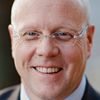
Twenty years ago on July 14, Elizabeth Glaser gave a speech that was a wake-up call for the nation on the issue of AIDS.
As she herself admitted to the audience at the 1992 Democratic National Convention, she was an unlikely spokesperson for the disease -- a former school teacher and mom, living in Los Angeles and married to a famous actor.
AIDS was something that was very far from her reality, or at least it seemed that way.
By 1992, Elizabeth had been living with the virus for more than a decade. She had been infected with HIV through a blood transfusion after the birth of her daughter Ariel in 1981, the same year that the first cases of AIDS were reported in Los Angeles.
Elizabeth had unknowingly passed the virus on to Ariel through breastfeeding, and later to her son Jake during pregnancy. She didn't learn about her own HIV status until 1986, when Ariel was five years old and already very ill.
Though the FDA approved the drug AZT as the first treatment for AIDS the following year, it wasn't available for children. Despite the urgency and need of families like Elizabeth's, AZT wouldn't be approved for pediatric use until 1990. This came too late for Ariel, who passed away in 1988.
By the time Elizabeth was standing at that podium, she was literally fighting for her own life, the life of her son Jake, and thousands of other children and mothers throughout the country.
After Ariel's death, Elizabeth tried to shake the nation out of ignorance and discrimination toward those affected by the epidemic, and from an attitude that "It's not my problem."
She demanded more research on treating and preventing AIDS in children, and was fearless about knocking on doors and barging into offices in the halls of Congress and at the National Institutes of Health.
In her speech, she declared, "Once every generation, history brings us to an important crossroads" -- and she was right.
In 1994, a groundbreaking study showed that giving AZT to pregnant women could block transmission of HIV from mother to child by up to 70 percent. Research primarily funded by the National Institutes of Health led to even more effective regimens, eventually reducing the risk of mother-to-child transmission to less than 2 percent.
Within just a few years, almost all pregnant HIV-positive women in the U.S. were receiving this drug regimen as standard protocol, and pediatric AIDS soon became a rarity here.
The same can't be said for the rest of the world. Every day there are about 1,000 new HIV infections in children, mostly in sub-Saharan Africa through mother-to-child transmission. And only about half of women globally are receiving the most effective drugs to protect their own health and prevent these infections in their children.
As the historic AIDS 2012 Conference opens in Washington, D.C. next week, we stand at another crossroads for children and HIV.
There has been a decade of dramatic progress in preventing and treating pediatric AIDS around the world. A global plan introduced last year by the U.S. and UNAIDS has mobilized governments, international organizations, the private sector, and communities around the achievable goal of ending new HIV infections in children, and keeping their mothers alive and healthy.
There is gathering momentum toward an AIDS-free generation, but it will take increased political leadership and a commitment of resources to turn the tide and prevent us from backsliding on our incredible achievements to date.
It will also take the tenacity of mothers like Elizabeth.
"I started out just a mom, fighting for the life of her child," she said.
Today there are millions of mothers carrying on that same fight -- and we must join them.
On this anniversary, I think about what Elizabeth would say of our progress against this disease, with global HIV programs reaching a scale almost unimaginable 20 years ago. I think she would be proud of the leadership the U.S has shown fighting AIDS around the world.
But I also imagine that she would be impatient. When the medicines and means exist to ensure that no mother need pass on the virus to her baby, why are only half of women around the world receiving them? Why are so many children living with HIV not getting tested and receiving lifesaving HIV treatment?
I think she would also shine a light on our challenges here at home. She would ask why HIV rates are creeping up again in certain populations. Why are we not reaching every one of the 8,000 HIV-positive women who give birth in the U.S. annually, to reduce the number of pediatric HIV infections to zero?
And why does our nation's capital -- the host of this year's International AIDS Conference -- have an HIV prevalence rate that rivals some countries in sub-Saharan Africa?
At the AIDS 2012 Conference, we'll be asking similar questions, and channeling the spirit and passion that Elizabeth exhibited at such a pivotal moment 20 years ago.
As she told the rapt crowd, "Sometimes in life there is that moment when it's possible to make a change for the better."
Once again, this is one of those moments.
